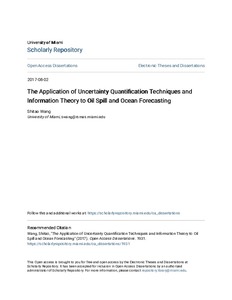| dc.contributor.author | Wang, Shitao | |
| dc.date.accessioned | 2020-11-17T19:03:41Z | |
| dc.date.available | 2020-11-17T19:03:41Z | |
| dc.date.issued | 2017 | |
| dc.identifier.citation | Wang, S. (2017) The Application of Uncertainty Quantification Techniques and Information Theory to Oil Spill and Ocean Forecasting. University of Miami, PhD Thesis, 118pp. (Open Access Dissertations 1931) DOI: http://dx.doi.org/10.25607/OBP-951 | en_US |
| dc.identifier.uri | http://hdl.handle.net/11329/1448 | |
| dc.identifier.uri | http://dx.doi.org/10.25607/OBP-951 | |
| dc.description.abstract | Quantifying uncertainties in ocean current forecasts is an important component of
formulating a response to an oil spill, e.g. to compute the anticipated oil trajectories.
Polynomial Chaos (PC) methods have recently been used to quantify uncertainties in
the circulation forecast of the Gulf of Mexico caused by uncertain initial conditions
and wind forcing data. The input uncertainties consisted of the amplitudes of perturbation
modes whose space-time structure was obtained from Empirical Orthogonal
Functions (EOF) decompositions. These e orts were the rst to rely on a PC approach
to e ciently quantify uncertainties in an ocean model, and as such have raised
a number of issues that we wish to address, namely the realism of the perturbations,
the e ective choices in choosing the uncertain variables, the information trade-o s of
the di erent uncertain input choices, and the ability to reduce these uncertainties if
observational data is available.
We explore whether these EOF-based perturbations lead to realistic representation
of the uncertainties in the circulation forecast of the Gulf of Mexico. We also use
information theoretic metrics to quantify the information gain and the computational
trade-o s between di erent wind forcing and initial condition EOF modes. Surface
and subsurface model data comparisons show that the observational data falls within
the envelope of the ensemble simulations and that the EOF decompositions deliver
\realistic" perturbations in the Loop Current region. The result of the computational
trade-o s indicate that two initial condition EOF modes are enough to represent the
uncertainties in the Loop Current region; while wind forcing EOF modes are necessary
in order to capture uncertainties in the coastal zone. This result is consistent with
the global sensitivity analysis.
The ensemble statistics are then explored using the PC approach and the newly
developed contour boxplot method. Specifically, the contour boxplot is used to identify
the most representative ensemble member and the outliers. The full probability
density functions of sea surface height are estimated using the PC method. With 20
years of satellite observations, the predictability in the circulation forecast of the Gulf
of Mexico is investigated using information theory.
Finally, we update our knowledge about the uncertain inputs using along track
satellite observations. The best initial perturbations are found using the Bayesian
optimization approach and the full posterior distributions of the uncertain inputs are
estimated using the Bayesian inference framework. | en_US |
| dc.language.iso | en | en_US |
| dc.publisher | University of Miami (PhD Thesis) | en_US |
| dc.title | The Application of Uncertainty Quantification Techniques and Information Theory to Oil Spill and Ocean Forecasting. | en_US |
| dc.type | Other | en_US |
| dc.description.status | Published | en_US |
| dc.publisher.place | Coral Gables, Florida | en_US |
| dc.subject.parameterDiscipline | Parameter Discipline::Physical oceanography::Currents | en_US |
| dc.description.currentstatus | Current | en_US |
| dc.description.sdg | 14.A | en_US |
| dc.description.bptype | Manual (incl. handbook, guide, cookbook etc) | en_US |
| obps.contact.contactname | Shitao Wang | |
| obps.resourceurl.publisher | https://scholarlyrepository.miami.edu/oa_dissertations/1931 | en_US |
 Repository of community practices in Ocean Research, Applications and Data/Information Management
Repository of community practices in Ocean Research, Applications and Data/Information Management
